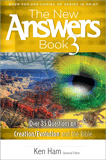Fruit Design: Any Way You Slice It
From Unlocking Science with Roger Patterson
From the giant jackfruit to the smelly durian to the humble apple, thousands of fruit varieties sweeten our menu. Beyond merely delighting our palettes, fruits reveal the Creator’s masterful design.
On day three of creation week, God created plants according to specific kinds that would reproduce more of the same kind. That means that apple trees will always produce apples, never oranges or any other kind of fruit.
Look It Up
Look for the word fruit in the Bible. Find a passage referring to a literal fruit and one where a fruit is used in a metaphor to represent something.
Fruits are structures that hold seeds and often have fleshy parts we enjoy eating. Many of the foods we commonly call vegetables are actually fruits. If you cut into a cucumber, tomato, or avocado, you will find seeds. That makes them fruit in the eyes of a botanist (plant scientist).
A fruit always begins with a flower. The flower’s female ovary develops into the fruit with the seeds inside. The structure of the fruit reflects the structure of the flower. In many cases, the number of petals or sepals (leaf-like structures that protect a bud or support a flower’s petals) matches the number of the plant’s ovaries. For example, an apple flower has five sepals and five petals matching the pattern of the ovaries.
God designed the structure of each fruit to aid in spreading the seeds. Round fruits can roll to places where they decompose, allowing the seeds to grow. Tiny berry seeds travel through the digestive tracts of animals and are deposited in new areas.
You can learn a lot about God’s design by examining the fruit he’s made. Grab your favorite pieces of fruit and get ready to slice and dice—and maybe even munch!
Materials Needed
- Sharp knife
- Tweezers
- Cutting board
- Magnifying glass
- Paper plate or tray
- 2 large fruits (such as an apple, kiwi, cantalope, plum, strawberry, cucumber, or dragonfruit)

Step One—Examine Exterior
Examine the fruit’s exterior. Note any distinct features like color, shape, texture, and presence of leaves, sepals, stems, or other structures.

Step Two—Cross-Section Cut
- Make a cross-sectional cut across the center of the fruit and note the structures. Sketch one of the sections. How many seeds were present? How were the seeds in this plant arranged inside the ovary? Based on the structure of the fruit, how would the seeds most likely spread to find new places to grow? Find a picture of the fruit’s flower. How does the number of ovaries compare to the number of petals?
- Make more cross-sectional cuts and compare each slice to the others.

Step Three—Longitudinal Cut
On the second fruit, make a longitudinal cut (top to bottom) and again note the structures. Sketch one of the sections.
Step Four—Taste Test
If you have used clean tools and the fruit is edible, take a bite and describe the taste and texture of the fruit.
Answers Magazine
January–March 2021
Meet the team of artists and writers behind the world’s most pro-life museum exhibit.
Browse Issue SubscribeRecommended Resources

Answers in Genesis is an apologetics ministry, dedicated to helping Christians defend their faith and proclaim the good news of Jesus Christ.
- Customer Service 800.778.3390
- © 2024 Answers in Genesis





